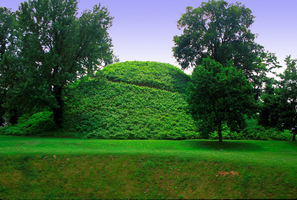 | Back to e-WV
| Back to e-WV
 The West Virginia Encyclopedia
The West Virginia Encyclopedia
 | Back to e-WV
| Back to e-WV
 The West Virginia Encyclopedia
The West Virginia Encyclopedia

Grave Creek Mound in Moundsville is the largest conical earthen mound in North America, making it a significant national landmark. The mound currently is 62 feet high and 240 feet in diameter at the base and is estimated to contain 57,000 tons of earth. Archeologists speculate that three million basket-loads of earth were necessary to construct it.
Excavations conducted by the West Virginia Geological and Economic Survey in 1975 and 1976 identified a moat surrounding the mound, originally measuring 910 feet long, 40 feet wide, and four to five feet deep. At one time at least one passageway crossed the moat on the south side of the mound. Soil excavated from the moat was used in some stages of mound construction. Charcoal samples recovered from excavations yielded a radiocarbon date of 200 B.C., suggesting completion of moat construction at that time. It is believed that mound construction began sometime during the third century B.C. This is referred to as the Early Woodland period (1000–200 B.C.) by archeologists. The Grave Creek Mound is typical of many Adena (500 B.C.–A.D. 200) earthworks found throughout the Ohio Valley.
The first detailed description of the mound was written by Nicholas Cresswell in 1775. In March 1838, Abelard Tomlinson and his brother-in-law, Thomas Biggs, began digging at the mound. Tomlinson’s excavations identified two burial vaults or tombs. The upper vault contained one individual surrounded by 1,700 bone and shell beads, five copper bracelets, a gorget, and several rectangular pieces of mica. The lower vault contained two individuals (male and female) surrounded by 650 shell beads. The male was buried with an atlatl (spear-thrower) weight.
The most controversial item rumored to have been found in the upper vault was a small inscribed tablet of sandstone, the infamous Grave Creek Tablet. At the time of discovery, many thought the inscriptions were covered in runes, or Norse writings, lending credence to the myth that the mounds were built by a lost tribe or civilization. Others believe that the tablet was a hoax. The matter has yet to be resolved.
Following Tomlinson’s investigations, his excavation tunnels were vaulted with bricks, and the mound became a tourist attraction. At various times throughout the remainder of the 19th century, the mound had a saloon and Civil War artillery on its summit, and horse races were often run around the base.
In 1909, the legislature appropriated funds to purchase the mound. The mound adjoined the state penitentiary and was placed under the supervision of the prison warden. It was largely through the efforts of Delf Norona and the West Virginia Archeological Society that the original Mound Museum opened in 1952. The Grave Creek Mound was listed as a National Historic Landmark in 1964. In 1967, it became Grave Creek Mound State Park, and in 1978, the Delf Norona Museum was opened beside the mound. It is now part of the Grave Creek Mound Archaeological Complex, operated by the West Virginia Department of Arts, Culture and History.
Read the National Historic Landmark nomination.
Written by Patrick D. Trader
McMichael, Edward V. Introduction to West Virginia Archeology. Morgantown: West Virginia Geological & Economic Survey, 1968.
Norona, Delf. Moundsville's Mammoth Mound. Moundsville: West Virginia Archeological Society, 1954, Reprint, West Virginia Archeological Society, 1998.
Hemmings, E. Thomas. Investigations at Grave Creek Mound 1975-1976. West Virginia Archeologist, 1984.